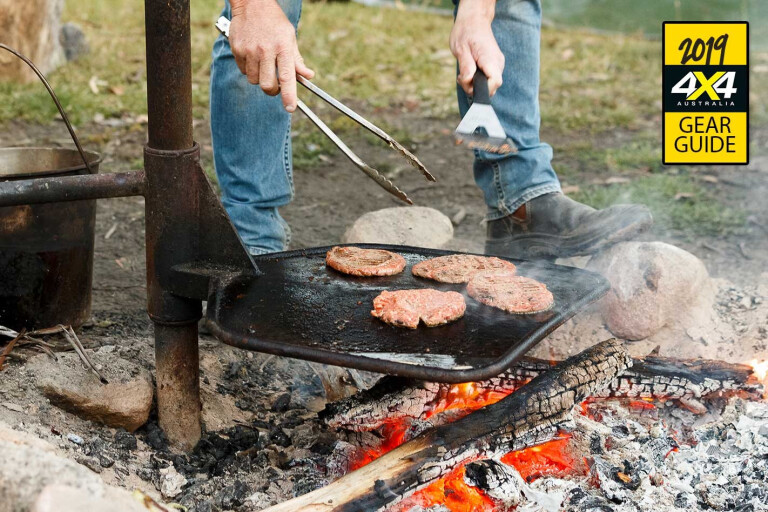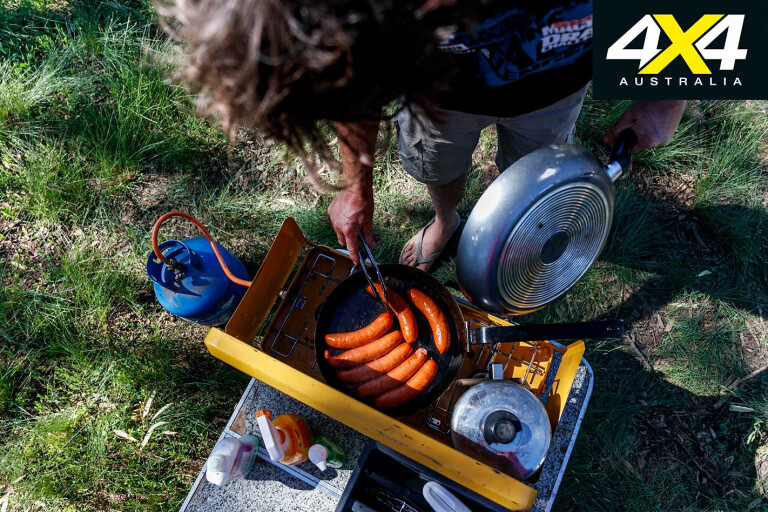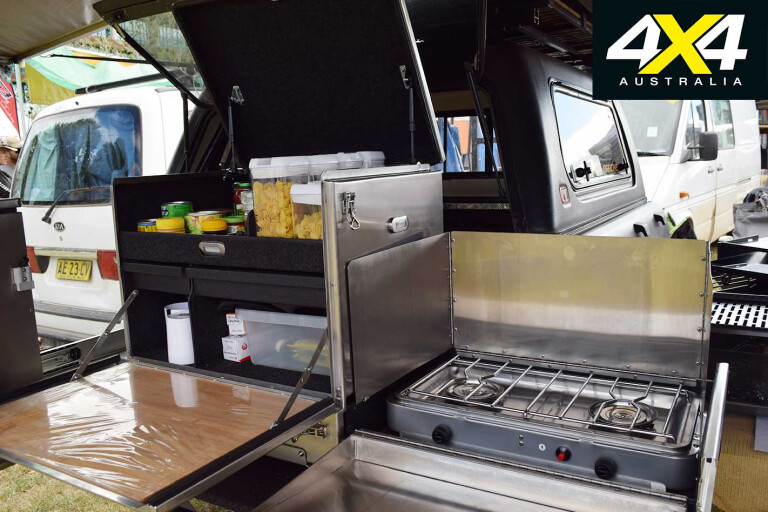
Everyone’s gotta eat, right? Luckily there are plenty of cooking options for 4x4 tourers, from the humble campfire, to lightweight hiking cookers, to slide-out kitchens with multiple gas burners. The right one for you will depend on the size of your clan, what you like to eat and the style of your touring set-up.
Campfires

Cost: Free … or a few bucks for a bag of wood.
Availability of fuel: In some places there’s plenty, in others you’ll have to go looking or bring your own.
Pros: There’s nothing better than cooking on a campfire. The smoke adds flavour to barbecued food, you can bury your spuds in the coals, you can boil your billy on it, and you can warm up beside it on a cold night. And the fire is always the campsite social centre.
Cons: You can’t use campfires when there’s a fire ban, wood can sometimes be hard to find, and, if it is wet, it’s a struggle to get a fire going.
Canister stoves

Cost: Canister stoves range in price from relatively cheap units that simply screw on to the top of a disposable canister to more expensive, super lightweight hiking cookers that can cost a lot more. The canisters themselves are not expensive, but they don’t offer as much burn-for-your-buck as LPG. Plus, they aren’t refillable.
Availability of fuel: Availability is dependent on the style of canister required. Some popular canisters can be purchased at most service stations and hardware stores, while most variants can be found in camping stores.
Pros: Canister stoves are small, lightweight, easy to fire up and quick to pack away. If you only have one pot to heat, they are very convenient.
Cons: Canister stoves do not cook as quickly as campfires or LPG stoves, and the disposable canisters are not exactly environmentally friendly; and you’ll have to find somewhere to stow the empties until you can get rid of them.
A variety of fuels are used in disposable canisters including propane, butane and isobutane. If the ambient temperature is low enough to turn the canister fuel into a liquid state, upright stoves will not operate at all. Butane boils at -0.5°C and propane boils at -42°C, so if you’re going to use your stove in extremely cold conditions, it’s important to choose the right fuel blend.
Alternatively, low-profile canister stoves have a burner that’s connected to the canister via a fuel hose, offering better cold-weather performance than upright stoves, while some hiking stoves offer dual-fuel capability; a liquid fuel, such as shellite (in a fuel bottle), is far less affected by cold weather than canister-based fuel.
Lunch box cooker

Cost: Lunch box stoves are cheap, ranging in price from as little as $20 to around $50.
Availability of fuel: You can buy butane cartridges at most supermarkets, variety stores and hardware stores, as well as at many service stations.
Pros: With a convenient disposable butane cartridge, Piezo ignition and a compact plastic carry case, it is little wonder lunch box cookers can be found in just about every campsite around the country. They are extremely easy to use, offer a stable cooking platform, are easy to store, and don’t take up much space.
Cons: The cartridges are not refillable and you’ll need to find a place to stow the empties prior to proper disposal. Butane is not as efficient as LPG, especially in very cold conditions, so cooking times will be slower.
Some early lunch box cookers had a faulty safety-release mechanism (designed to eject the butane canister if it overheated) resulting in injuries and even a death in Australia. If you have an old lunch box cooker, get rid of it and buy a post-recall model.
LPG stoves

Cost: LPG stoves range in price from just a few bucks for a single burner to several hundreds of dollars for a multi-burner barbecue. The gas bottles are inexpensive to refill, especially considering the high efficiency of LPG fuel.
Availability of fuel: Most service stations and hardware stores either refill LPG bottles or offer a convenient, albeit slightly more expensive, exchange program.
Pros: LPG bottles can be used to fuel several styles of cooking devices from small to large. The fuel is efficient, providing fast cooking. The gas bottles are refillable and available in a variety of capacities from as little as 1kg to 9kg. LPG can also be used to fuel camp lighting and to power three-way fridge/freezers.
Cons: The gas bottles have a 10-year lifespan, after which they must be inspected and re-stamped, or replaced altogether; but, using a gas bottle exchange program resolves this issue. LPG is very flammable, so the bottles will need to be stored securely and the fuel line/governor checked regularly for leaks. Large gas bottles are heavy.

COMMENTS